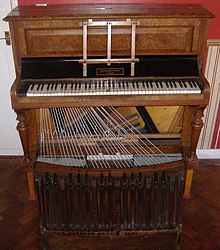Pedal piano
The pedal piano is a stringed keyboard instrument which, in addition to the manual (from Latin manus 'hand'), is equipped with a pedal keyboard (from Latin pedalis 'belonging to the foot'), like an organ.
variants
Related forms the pedal clavichord , the pedal harpsichord and pedal piano . The considerable technical difficulties in the construction and the spatial accommodation of the additional pedals, the required additional bass strings and the corresponding mechanics led to different solutions, which were reflected in different construction methods.
history
As early as the 15th century, text sources can be found in which the pedal clavichord is used as a training instrument for organists. A preserved example from 1760, built by Johann Gerstenberg, is in the Instrument Museum in Leipzig .
In the 18th and 19th centuries, hammer pianos and grand pianos were built with an additional pedal keyboard and enjoyed increasing popularity beyond their use as a practice instrument. Wolfgang Amadeus Mozart had the piano maker Anton Walter build an independent pedal piano under his grand piano in 1785, which he used to improvise at concerts.
A pedal grand piano built by Ludwig Bösendorfer in Vienna in 1874 and preserved playable is in the collection of the Gesellschaft der Musikfreunde in Vienna and is used for concerts. Robert Schumann, who also composed for this instrument, as well as Franz Liszt, Charles Gounod and several other composers, was also fascinated by the possibilities of the pedal grand. Even in the 21st century there are compositions for pedal pianos again.
Compositions (selection)
-
Alexandre Pierre François Boëly (1785-1858)
- Douze Piéces op.18
-
Robert Schumann (1810-1856)
- Studies , op.56
- Sketches , op.58
- Six fugues about the name BACH Op. 60
-
Franz Liszt (1811-1886)
- Fantasy and fugue on "Ad nos ad salutarem undam" (1850)
-
Charles Valentin Alkan (1813–1888)
- Onze Grands Preludes et une transcription du Messiah de Handel Op. 66 (1857-1867)
- Benedictus op.54 (1859)
- Treize Prières op.64 (1865)
- Impromptu sur le choral de Luther "A strong castle is our God" op. 69 (1866)
-
Charles Gounod (1818-1893)
- Marcia Solenne (1878)
- Fantasie sur l'hymne national russe (with orch.) (1886)
- Suite Concertante (with orch.) (1888)
- Danse Roumaine (with orch.) (1896)
-
Théodore Salomé (1834-1896)
- Dix Pièces , (ca.1890)
-
Camille Saint-Saëns (1835-1921)
- Concerto (with orch.) (First version of the 2nd piano concerto) (1868)
-
Léon Boëllmann (1862-1897)
- Douze pieces Op. 16
-
Franco Oppo (1935-2016)
- Be very happy o my soul (2000)
-
Fabrizio Marchionni (* 1976)
- S'Indàssa (2000)
-
Jean Guillou (1930-2019)
- Epitases (2002)
-
Charlemagne Palestine
- From Etudes to Cataclysm (2005)
-
Ennio Morricone
- Studio IV until (2011)
- Studio 4 per pianopedaliera (2012)
-
Andrea Morricone
- Omaggio a JSB (2011)
-
Giuseppe Lupis
- Variazioni su “Ah! Vous Dirai-je, Maman "(2011)
-
Cristian Carrara
- Magnificat for pedal piano and orchestra (2011)
-
Nimrod Borenstein
- Fireworks , for pedal piano (2011)
-
Michael Glenn Williams
- Tip-Tap (2011)
-
Francesco Trocchia
- Trio (pedal piano, cello and French horn) (2013)
- Diapositive di una metamorfosi , for pedal piano, violin and cello (2014)
-
Luca Lombardi
- Mendelssohn in the Jewish Museum Berlin , for pedal pianos (2014)
Discography (selection)
- Martin Schmeding: Robert Schumann: The complete works for pedal pianos. Hybrid SACD. Label: Ars Production, 2008
- Olivier Latry: pedal wing. Boëly: Fantasy & Fugue op. 18 No. 6; Andante con moto op. 18 No. 1 & op. 43 No. 7; Toccata Op. 43 No. 13; Allegro ma non troppo op. 18 No. 7; Liszt: Evocation a la Chapelle sixtine; Prelude & Fugue on BACH; Schumann: 4 sketches op. 58; Brahms: Prelude & Fugue WoO 10; Alkan: Preludes op.66 No. 5 & 10. Naive, DDD, 2011.
literature
- Jacques Handschin : The Pedal Piano, ZfMw XVIII, 1935.
- Pedal piano . In: Brockhaus Riemann Musiklexikon , p. 7919.
- Martin Schmeding: The pedal grand piano - instrumental revolution or dead end of musical evolution. For the 200th birthday of Robert Schumann. In: Ars Organi , volume 2010/09. on-line
Individual evidence
- ↑ P. 139 in: Martin Schmeding: The Pedal Grand Piano - Instrumental Revolution or Dead End of Musical Evolution? For the 200th birthday of Robert Schumann. In: Ars Organi . 58th century, no. September 3 , 2010.
- ↑ P. 140 in: Martin Schmeding: The Pedal Grand Piano - Instrumental Revolution or Dead End of Musical Evolution? For the 200th birthday of Robert Schumann. In: Ars Organi . 58th century, no. September 3 , 2010.
- ^ Pedalflügel Gesellschaft der Musikfreunde in Vienna ( memento from January 20, 2015 in the Internet Archive ) on the Bösendorfer website.
- ↑ S. 142f in: Martin Schmeding: The Pedal Piano - Instrumental Revolution or Dead End of Musical Evolution? For the 200th birthday of Robert Schumann. In: Ars Organi . 58th century, no. September 3 , 2010.
